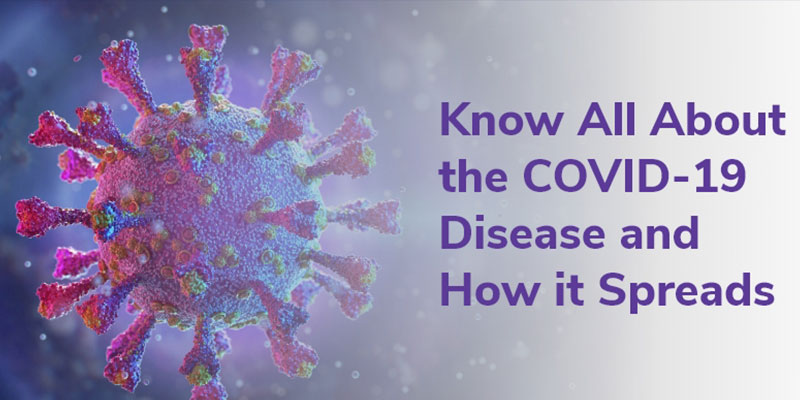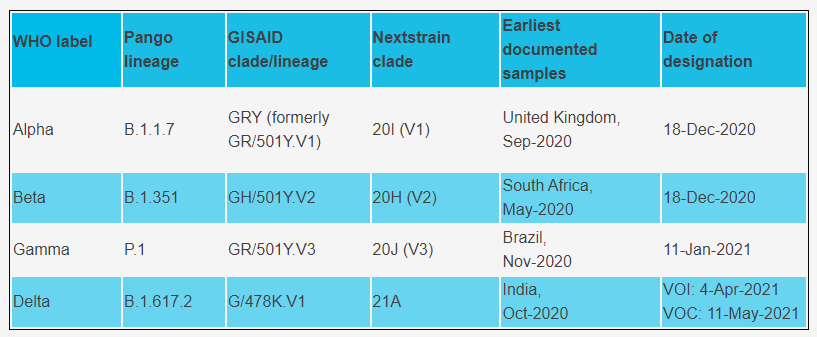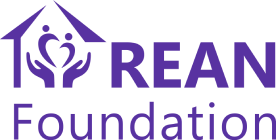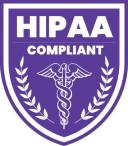
Know All About the COVID-19 Disease and How it Spreads
What is COVID-19? Meaning of COVID-19 word?
Coronavirus disease (COVID-19) is an infectious disease caused by a newly discovered coronavirus. In the word ‘COVID-19’ - 'CO' stands for corona, 'VI' denotes virus, and 'D' stands for disease. Formerly, this disease was referred to as '2019 novel coronavirus' or '2019-nCoV.'
What is a virus & coronavirus?
Viruses are microscopic pathogens that reproduce only inside the living cells of organisms. Coronavirus is a type of virus that was identified in 2019, SARS-CoV-2. It has been the primary cause of a global pandemic of a respiratory illness called COVID-19.
What are the most common modes of transmission of viruses in general?
Viruses spread through various modes of transmission. They are mainly categorized as:
a. Contact transmission can happen through direct or indirect contact. Direct contact transmission happens where disease-causing microorganisms pass from the infected person to the healthy person through direct physical contact of blood or body fluids. Body fluids could pass from one person to the other through actions like touching, kissing, or sexual intercourse. Indirect contact transmissions happen when an infected individual sneezes or coughs, passing infectious droplets into the air. If healthy individuals inhale the virus-containing droplets, or if those droplets land directly in their eyes, nose, or mouth, they risk getting infected with the disease.
b. Vehicle transmission refers to the transmission of disease-causing pathogens by means of a medium that could be water, food, or air. Waterborne diseases can be caused by the contamination of a water source due to poor sanitation methods. Airborne diseases are caused when pathogens are transmitted from an infected to a healthy person through aerosols, dust, and fine particles that float in the air.
c. Vector transmission refers to infectious diseases that spread through a mechanical or biological vector. Biological transmission of infection happens via a second population (vectors). Vectors are arthropods that feed on blood, such as mosquitoes, sandflies, or ticks. While feeding on an infected animal/person, the vector carries the infection causing pathogens that might multiply within its body and then transmits it to another human/animal. Fleas, ticks, and mosquitoes are common biological vectors of disease. Mechanical transmission can happen when a vector such as flies picks up infectious agents on the outside of their bodies and transmit them through physical contact, without being infected.
Also Read: Use of technology in COVID-19 management
How does coronavirus spread?
Researchers have found that the virus that causes coronavirus disease 2019 (COVID-19) spreads mainly from humans to humans via respiratory droplets that are released when someone with the infection coughs, sneezes or talks. Another less common way of transmission is an airborne transmission. This occurs when smaller droplets containing virus particles stay suspended in the air for a longer duration and over longer distances, they can potentially infect healthy people in the same area — even when the infected person is far or has left the space some time ago.
Many times there are people who carry the infection but do not show any signs or symptoms of the disease. These individuals can be carriers and spread the virus to others. The COVID-19 transmission can happen in several ways:
Aerosols or Droplets. This is the most common form of transmission across the globe. The disease gets transmitted when a person infected with COVID-19, sneezes, coughs, or talks. When this happens, many small droplets or tiny particles, also known as aerosols, transmit the virus from his/her nose or mouth into the surrounding air. This is dangerous for anyone within the range of 6 feet around the infected person.
Airborne transmission. Researchers have found that the virus responsible for COVID-19 is able to survive in the air for as long as 3 hours. You could risk getting infected if you breathe in the air around an infected person. Cases of transmission from people more than 2 meters apart have occurred but in enclosed spaces with poor ventilation, and typically with extended exposure to an infected person of more than 30 min.
Surface transmission. This is not the primary mode of transmission but poses a large risk. When a healthy person touches surfaces that have the virus left by someone else’s cough or sneeze, they are in danger of getting infected. You are at high risk if you touch a tabletop or door handle that has the virus and then use the same hand to touch your mouse, nose, or eyes. Therefore, doctors and scientists stress the need to wash or sanitize your hands multiple times a day and disinfect the surfaces, doorknobs, etc that are used by multiple people on a daily basis.
Fecal-oral. Scientists have conducted studies that confirm the presence of the virus in the feces of the infected people. But experts are uncertain if the infection may spread via contact with an infected individual’s stool. If a person carrying the COVID-19 virus uses the washroom and did not wash hands hygienically, they could risk infecting surfaces and others who use that area.
How does the virus mutate?
Variants of viruses occur when there is a change or mutation to the virus’s genes. Viruses undergo mutations throughout their lifespan. If a mutation has the advantage of survival, then the mutated version becomes the dominant strain. Just as chameleons change their skin color to avoid predators, the COVID-19 virus continues to evolve to evade its predator – the human immune system that fights the virus.
What are various COVID variations?
Here are the variants of concern updated by WHO as of 31 May 2021:

The most effective way to control the spread of the Coronavirus pandemic and slow down the transmission rate is to be aware of the virus, how it spreads and which behavioral practices should be used to keep it at bay. We all need to protect ourselves and others around us from the infection by washing our hands regularly or using an alcohol-based hand sanitizer. Learn more on how to prevent COVID-19 and improve your safety by getting vaccinated.
The intelligent assistant, REAN Health Guru, developed by REAN Foundation, answers all your questions about COVID-19 from authentic medical resources. Click here to go through other FAQs.
What is COVID-19? Meaning of COVID-19 word?
Coronavirus disease (COVID-19) is an infectious disease caused by a newly discovered coronavirus. In the word ‘COVID-19’ - 'CO' stands for corona, 'VI' denotes virus, and 'D' stands for disease. Formerly, this disease was referred to as '2019 novel coronavirus' or '2019-nCoV.'
What is a virus & coronavirus?
Viruses are microscopic pathogens that reproduce only inside the living cells of organisms. Coronavirus is a type of virus that was identified in 2019, SARS-CoV-2. It has been the primary cause of a global pandemic of a respiratory illness called COVID-19.
What are the most common modes of transmission of viruses in general?
Viruses spread through various modes of transmission. They are mainly categorized as:
a. Contact transmission can happen through direct or indirect contact. Direct contact transmission happens where disease-causing microorganisms pass from the infected person to the healthy person through direct physical contact of blood or body fluids. Body fluids could pass from one person to the other through actions like touching, kissing, or sexual intercourse. Indirect contact transmissions happen when an infected individual sneezes or coughs, passing infectious droplets into the air. If healthy individuals inhale the virus-containing droplets, or if those droplets land directly in their eyes, nose, or mouth, they risk getting infected with the disease.
b. Vehicle transmission refers to the transmission of disease-causing pathogens by means of a medium that could be water, food, or air. Waterborne diseases can be caused by the contamination of a water source due to poor sanitation methods. Airborne diseases are caused when pathogens are transmitted from an infected to a healthy person through aerosols, dust, and fine particles that float in the air.
c. Vector transmission refers to infectious diseases that spread through a mechanical or biological vector. Biological transmission of infection happens via a second population (vectors). Vectors are arthropods that feed on blood, such as mosquitoes, sandflies, or ticks. While feeding on an infected animal/person, the vector carries the infection causing pathogens that might multiply within its body and then transmits it to another human/animal. Fleas, ticks, and mosquitoes are common biological vectors of disease. Mechanical transmission can happen when a vector such as flies picks up infectious agents on the outside of their bodies and transmit them through physical contact, without being infected.
Also Read: Use of technology in COVID-19 management
How does coronavirus spread?
Researchers have found that the virus that causes coronavirus disease 2019 (COVID-19) spreads mainly from humans to humans via respiratory droplets that are released when someone with the infection coughs, sneezes or talks. Another less common way of transmission is an airborne transmission. This occurs when smaller droplets containing virus particles stay suspended in the air for a longer duration and over longer distances, they can potentially infect healthy people in the same area — even when the infected person is far or has left the space some time ago.
Many times there are people who carry the infection but do not show any signs or symptoms of the disease. These individuals can be carriers and spread the virus to others. The COVID-19 transmission can happen in several ways:
Aerosols or Droplets. This is the most common form of transmission across the globe. The disease gets transmitted when a person infected with COVID-19, sneezes, coughs, or talks. When this happens, many small droplets or tiny particles, also known as aerosols, transmit the virus from his/her nose or mouth into the surrounding air. This is dangerous for anyone within the range of 6 feet around the infected person.
Airborne transmission. Researchers have found that the virus responsible for COVID-19 is able to survive in the air for as long as 3 hours. You could risk getting infected if you breathe in the air around an infected person. Cases of transmission from people more than 2 meters apart have occurred but in enclosed spaces with poor ventilation, and typically with extended exposure to an infected person of more than 30 min.
Surface transmission. This is not the primary mode of transmission but poses a large risk. When a healthy person touches surfaces that have the virus left by someone else’s cough or sneeze, they are in danger of getting infected. You are at high risk if you touch a tabletop or door handle that has the virus and then use the same hand to touch your mouse, nose, or eyes. Therefore, doctors and scientists stress the need to wash or sanitize your hands multiple times a day and disinfect the surfaces, doorknobs, etc that are used by multiple people on a daily basis.
Fecal-oral. Scientists have conducted studies that confirm the presence of the virus in the feces of the infected people. But experts are uncertain if the infection may spread via contact with an infected individual’s stool. If a person carrying the COVID-19 virus uses the washroom and did not wash hands hygienically, they could risk infecting surfaces and others who use that area.
How does the virus mutate?
Variants of viruses occur when there is a change or mutation to the virus’s genes. Viruses undergo mutations throughout their lifespan. If a mutation has the advantage of survival, then the mutated version becomes the dominant strain. Just as chameleons change their skin color to avoid predators, the COVID-19 virus continues to evolve to evade its predator – the human immune system that fights the virus.
What are various COVID variations?
Here are the variants of concern updated by WHO as of 31 May 2021:

The most effective way to control the spread of the Coronavirus pandemic and slow down the transmission rate is to be aware of the virus, how it spreads and which behavioral practices should be used to keep it at bay. We all need to protect ourselves and others around us from the infection by washing our hands regularly or using an alcohol-based hand sanitizer. Learn more on how to prevent COVID-19 and improve your safety by getting vaccinated.
The intelligent assistant, REAN Health Guru, developed by REAN Foundation, answers all your questions about COVID-19 from authentic medical resources. Click here to go through other FAQs.



